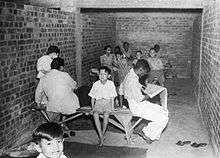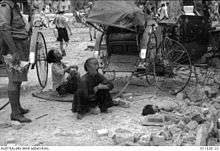Bombing of Singapore (1941)
| ||||||||||||||||||||||||||||||
The bombing of Singapore was an attack on 8 December 1941 by seventeen G3M Nell bombers of Mihoro Air Group (Mihoro Kaigun Kōkūtai),[2] Imperial Japanese Navy, flying from Thu Dau Mot in southern Indochina. The attack began at around 0430, shortly after Japanese forces landed on Kota Bharu, Malaya.[3] It was the first knowledge the Singapore population had that war had broken out in the Far East.[3]
Background
The attack on Singapore was assigned to 34 bombers of Genzan Air Group (Genzan Kaigun Kōkūtai) and 31 bombers of Mihoro Air Group.[4] Their targets were RAF Tengah, RAF Seletar, Sembawang Naval Base and Keppel Harbour.[5]
Six squadrons from both air groups took off from southern Indochina on the night of 7 December 1941. However, bad weather conditions were encountered while over the South China Sea.[4] Thick clouds offered poor visibility for the pilots, while rough winds caused most of the formations to become separated. After several attempts to regroup failed, Lieutenant Commander Niichi Nakanishi, Wing Commander of Genzan Air Group, ordered them to abort mission and return to base,[2] thereby reducing the impact of a much heavier raid.[4] Only seventeen G3M bombers of Mihoro Air Group reached Singapore on schedule, unobstructed by bad weather.[2]
The Attack
The Japanese formation was detected by a radar station in Mersing, Malaya, almost an hour before they reached Singapore. Three Brewster Buffalo fighters of No. 453 Squadron RAAF were on standby at RAF Sembawang. However, Flight Lieutenant Tim Vigors' request to scramble and intercept the Japanese bombers was denied.[6] Air Chief Marshal Robert Brooke-Popham feared that the anti-aircraft batteries would fire on the friendly fighters, despite Vigors being an experienced night fighter in the Battle of Britain. He was supplemented by the belief that the Buffalo fighter was only suited for daylight fighting and could not be used at night. Paradoxically, there were 12 Bristol Blenheim Mark IF night fighters of No. 27 Squadron RAF stationed in Sungai Petani, Malaya, but were being used as ground-attack aircraft.[7]
The streets were still brightly lit despite air raid sirens going off at 0400, allowing pilot navigators to locate their targets without difficulty. Air Raid Precautions (ARP) Headquarters was not even manned, and there was no blackout as police and power station officials could not find the employee who had the key to the switch (only two practice blackouts were conducted in September 1941 before the raid).[3] When the bombers began their attack at 0430, Allied anti-aircraft guns immediately opened fire. The battleship Prince of Wales and battlecruiser Repulse also responded, but no aircraft was shot down. A formation of nine bombers flew over without releasing their bombs to draw the searchlights and anti-aircraft guns away from the other group. They were flying at 12,000 feet, while the second formation was at 4,000 feet.[3]
Aftermath



The 'Raiders Passed' signal was sent out at 0500.[3] The bombers succeeded in bombing the airfields at Seletar and Tengah, damaging three Bristol Blenheim bombers of No. 34 Squadron RAF.[4] A number of bombs also fell on Raffles Place. 61 people were killed and more than 700 were injured. Most of the casualties were troops of the 2/2nd Gurkha Rifles, 11th Indian Infantry Division. The Japanese bombers all returned safely to Thu Dau Mot.[1]
Though the bombing caused only minor damage to the airfields, it stunned the British Far East Command. Despite intelligence reports of Japanese aircraft performance in the Second Sino-Japanese War, the command did not believe Japan's air forces were capable of striking Singapore from airfields more than 600 miles away in Indochina. The raid came as a surprise to Lieutenant General Arthur Percival, who "hardly expected the Japanese to have any very long-range aircraft."[4]
| “ | Rudely awakened in the small hours of the morning by the screams of air raid sirens and the roar of ack ack guns and in the clear moonlit sky around a formation of Japanese bombers. Bombs were dropped but none fell in our area. So the war in the Far East started – all day we heard news bulletins telling of the wide spread treachery of the Japs – Well! They've asked for it – !! – Diary and 'Line' book written by the pilots of No. 453 Squadron RAAF[8] | ” |
In the days that followed, Singapore enjoyed a considerable respite from air raids, as the Japanese focussed their attacks on key aerodromes and Allied positions in northern Malaya. The next raid on the island occurred on the night of 16/17 December 1941, which in itself was merely a minor attack on RAF Tengah by two Japanese Ki-21s. Only on the night of 29/30 December did nightly raids resume in earnest on Singapore City. In contrast, daylight raids commenced much later, on 12 January 1942, following the fall of Kuala Lumpur to the Japanese the previous day and the shifting of the bulk of the IJAAF to southern Malaya.
See also
References
Citations
- 1 2 First bomb raid on Singapore, Chua, Jeanne, 29 September 1997
- 1 2 3 Full text of "ZERO!", E. P. Dutton & Co. r Inc., retrieved 20 January 2010
- 1 2 3 4 5 Owen 2001, page 36
- 1 2 3 4 5 Burton 2006, page 96
- ↑ Stenman and Thomas, page 45
- ↑ Burton 2006, page 97
- ↑ The RAAF in Malaya, ww2australia.gov.au, retrieved 15 January 2010
Bibliography
- Lee, G. B. (1992). Syonan: Singapore under the Japanese 1942–1945 (pp. 18, 24). Singapore: Singapore Heritage Society.
- Singapore: An illustrated history 1941 – 1984 (p. 16). (1984). Singapore: Information Division, Ministry of Culture
- Tan, B. L. (1996). The Japanese Occupation 1942 – 1945: A pictorial record of Singapore during the war (pp. 16, 26–27). Singapore: Times Editions
- Stenman, Kari and Andrew Thomas. Brewster F2A Buffalo Aces of World War 2 (Aircraft of the Aces). Oxford, UK: Osprey Publishing, 2010. ISBN 978-1-84603-481-7.
- Owen, Frank. The Fall of Singapore. Penguin Books, 2001. ISBN 0-14-139133-2
- Burton, John. Fortnight of infamy: the collapse of Allied airpower west of Pearl Harbor. Naval Institute Press, 2006. ISBN 1-59114-096-X
External links
| Library resources about Bombing of Singapore (1941) |
| ||||||||||
